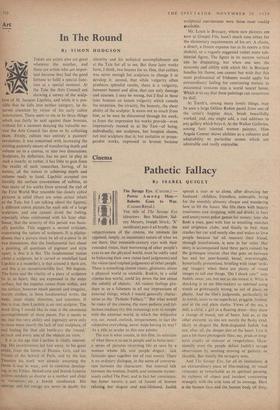Art
In The Round
By SIMON HODGSON THERE are artists who are great whatever the weather, and there are artists who are impor- tant because they had the good fortune to fulfil a special func- 111 at a special moment. At the Tate the Arts Council are showing a survey of the sculp- ture of M. Jacques Lipchitz, and while it is pos- sible that he falls into neither category, he de- serves attention by virtue of his early cubist innovations. There seem to me to be three things which can fairly be said against these bronzes, without for a moment denying the valuable ser- vice the Arts Council has done us by collecting them. Firstly, cubism was entirely a painters' revolution; it was concerned with increasing the existing painterly means of transferring depth and volume on to a canvas, or into two dimensions. Sculpture, by definition, has no part to play in such a search; or rather, it has little to gain from the results of such researches, having, of its nature, all the means to achieving depth and volume ready to hand. Lipchitz accepted too literally the surface conventions of cubism, so that many of his works from around the end of the First World War resemble too closely cubist pictures in relief (there are some actual reliefs at the Tate, brit I am talking about the figures), a different cubist picture for each side of a large sculpture; and one cannot avoid the feeling, especially when confronted with his later ebul- lience, that the severity of this period was basic- ally pastiche. This suggests a second criticism, concerning the nature of sculpture. It is platitu- dinous that a picture must be all-of-a-piece in its two dimensions, that the fundamental fact about a painting, all questions of pigment and style apart, is that it is flat. The fundamental truism about a sculpture, be it carved or modelled (and Lipchitz is a modeller), is that around it there are, and this is an incontrovertible fact, 360 degrees. The force and the vitality of a piece of sculpture lie at its heart: they are expressed in the outer surface, but the impetus conies fiom within, and the surface, however much pierced and irregular, merely clothes, in these fundamental terms, the basic, inner shape, direction, and intention. If this is true, then Lipchitz is no real sculptor. The third thing I would like to note is the enormous accomplishment of these pieces. For it seems to me that this very ability and ingenuity serve only to show more clearly the lack of real sculpture, of real feeling for that old battle-cry the 'round,' in each and every one of the objects on view.
It is in his age that Lipchitz is vitally interest- ing. His inventiveness led him away, to his great credit, from the forms of Picasso, Gris, and his friends of the School of Paris, and by the late Twenties his work was already assuming the forms it was to wear, and to continue develop- ing, in the Fifties. Melodrama and Jewish hysteria inform symbols as diverse as a mother and child or variations on a Jewish candlestick. His courage and his energy are never in doubt; his sincerity and his technical accomplishment are at the Tate for all to see. But these later works have, I think, two lessons for us. One, that cubism was never enough for sculpture to change it or develop it; second, that while vulgarity often produces splendid results, there is a vulgarity, however honest and alive, that can only damage and coarsen. I may be wrong, but I find in these later bronzes an innate vulgarity which cancels the invention, the vivacity, the honesty, the sheer ability of the sculptor. It stems not so much from him, as he may be discovered through his work, as from the impression his works provide—even impressively massed as at the Tate—of being, individually, not sculpture, but lumpish shams, not real sculpture that is, but imitative or propa- gandist works, expressed in bronze because sculptural conventions were those most readily available.
Mr. Louis le Brocquy, whose new pictures are now at Gimpel Fils, hasn't much time either for the elementary requirements of his art. A chaste, a desert, a frozen expanse has at its centre a thin skeletal, or a vaguely suggested rather more sub- stantial figure. The figure in its narrow vertical can be disquieting, but when one sees the economy and ability with which Mr. le Brocquy handles his theme, one cannot but wish that this most professional of Irishmen would apply his extraordinary feeling for contrasting texture to occasional ventures into a world nearer home. Which is to say that these paintings can sometimes be dull.
At Tooth's, among many lovely things, may be seen a large Odilon Redon pastel from one of the artist's happier days, brush beautifully worked, and, one might add, a real addition to any gallery which buys it. At the Walker Galleries, among four' talented women painters, Miss Angela Conner shows abilities as a colourist and adaptability to particular scenes which are admirable and really enjoyable.






































































 Previous page
Previous page